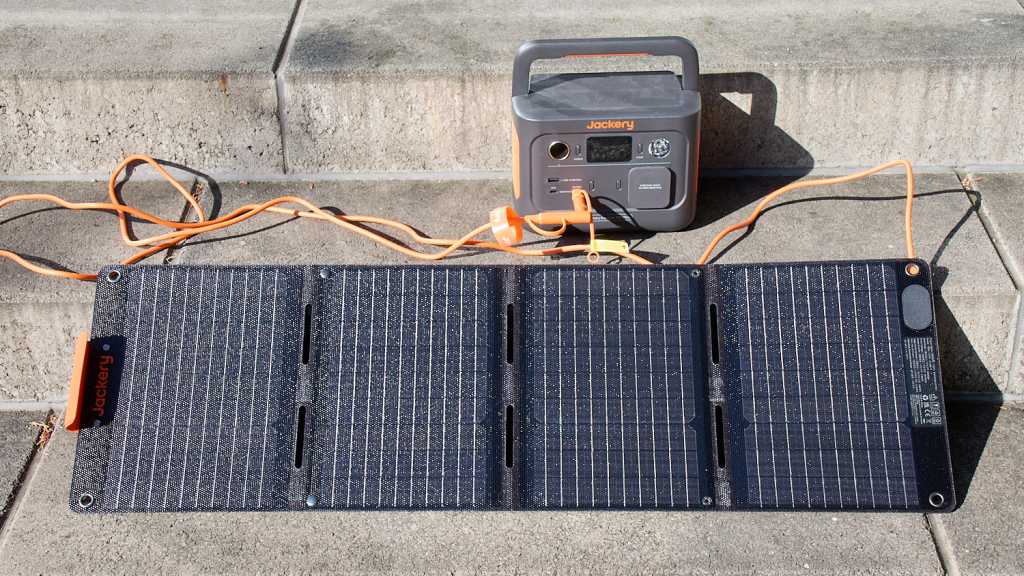
At a glance
Expert’s Rating
Pros
- Good display and workmanship
- 5-year warranty
- iPhone app control
- LiFePO4 battery
Cons
- Optional 40-watt solar panel may be underpowered for most users
Our Verdict
The Jackery Explorer 300 Plus Portable Power Station isn’t for users who need to regularly rely on a portable power station. It’s ideal for occasional use with light dependencies, such as charging devices while camping or powering a light source at a site. Conveniently, Jackery also offers a bundle with a 40-watt solar panel but it may be too underpowered for a lot of use cases.
Price When Reviewed
$299.99 (Power Station only)
Best Prices Today: Jackery Explorer 300 Plus Portable Power Station
$298

$299.99
It seems like rechargeable batteries are everywhere–phones, laptops, watches, you name it. We’ve come to rely on such battery-powered devices, but they all need to be recharged eventually. What can you do when you’re in a situation where you’re going to be nowhere near a power outlet for an extended period? You can get a portable power station–a device that’s a bit bigger than a lunchbox that houses a big battery that can carry enough power to charge or power small devices.
This review takes a look at such a device: the Jackery Explorer 300 Plus Portable Power Station. I also looked at the optional SolarSaga 40W Mini Solar Panel that works with the Explorer 300 Plus for charging the device with solar power.
Jackery Explorer 300 Plus Portable Power Station: Design, ports, battery
The Explorer 300 Plus weighs just 3.75 kilograms (8.27 pounds) and measures 23.1 by 15.4 by 16.8 centimeters (9.1 by 6.1 by 6.6 inches). It has a sturdy, compact shape with a carrying handle that can fold out of the way. It can even fit in a bigger backpack, like one you might use for camping, hiking, or another outdoor activity. Even if it doesn’t look like it, the housing is designed to withstand three drops from a height of 0.9 meters (3 feet). Jackery includes a five-year warranty.
Inside the Explorer 300 Plus is a LiFePO4 battery that holds 288 watt-hours of energy. According to Jackery’s website, the battery should have 70 percent capacity after 4,000 charging cycles. The device also has an integrated comprehensive protection circuit to protect the connected devices.
The 300 watts of output power is either available at the AC output (it has the appropriate U.S. or U.K. plug, depending on where you buy it), or a maximum of 100 watts at the two Power Delivery USB-C ports, and 15 watts at the USB-A port. The Explorer 300 Plus can be charged either via the AC input i(a full charge takes around 2 hours), the car adapter at the DC input (5.5 hours for a full charge), or via the USB-C input with a maximum of 100 watts (4 hours for a full charge). Suitable cables and adapters are included, with a cable bag.
The display in the center of the front is beautifully designed. It shows a large circle with the percentage of the battery status, and next to is a display for input and output power. Below each of these is an indication of how many hours the Explorer 300 Plus will take to charge at the current power level or how much energy it can still supply until it is empty. This information is a good indication of the actual time. If you want to see exactly how long the small Explorer 300 Plus can supply energy, you can find a wattage calculator on the Jackery homepage.
The Explorer 300 Plus has Wi-Fi and Bluetooth and you can use the Jackery iPhone app to control the device and adjust its settings.
We tested how powerful the small power station is by charging various Apple devices for 30 minutes. An iPhone 15 was charged by 51 percentage points with the displayed peak power at 19 watts. With an M3 MacBook Air, it charged 47 percent at around 65 watts of peak power. An M1 MacBook Air charged 34 percent and the iPad Pro 11-inch at 35 percent. These are all very good values.
Jackery SolarSaga 40W Mini Solar Panel option
If you’re going to use the Explorer 300 Plus while outdoors it seems like a good idea to charge it using a solar panel. Jackery offers various solar panels from 40 watts to 200 watts, and recommends the SolarSaga 40W Mini Solar Panel as an add-on for the Explorer 300 Plus for an additional price.
We measured the charging times with the SolarSaga 40W in the winter and spring sunshine. As you would expect, with a solar panel with a maximum output of only 40 watts, the Explorer 300 Plus only receives around 30 watts. In spring weather, it took around three hours to add 20 percent to the Explorer 300 Plus’s battery–on nicer days it was a bit faster.
If you are serious about charging the Explorer 300 Plus with solar power, you should plan for a larger solar panel, such as the SolarSaga 100W.
Should you buy the Jackery Explorer 300 Plus Portable Power Station?
The Jackery Explorer 300 Plus Portable Power Station isn’t for users who need to regularly rely on a portable power station. It’s ideal for occasional use with light dependencies, such as charging devices while camping or powering a light source at a site. Conveniently, Jackery also offers a bundle with a 40-watt solar panel but it may be too underpowered for a lot of use cases.
This article originally appeared on Macwelt and was translated by Roman Loyola.
This article originally appeared on our sister publication Macwelt and was translated and localized from German.





